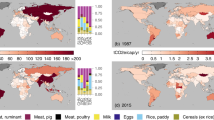
China, as the world’s largest importer, heavily relies on agricultural products. However, the impact of China’s free trade agreements (FTAs) on greenhouse gas (GHG) emissions embodied in agricultural product imports has been overlooked. It’s crucial to analyze changes in embodied GHG emissions resulting from FTAs. We categorize 367 agricultural products into 15 categories and construct a dataset on the embodied GHG emissions of these products imported by China from 119 countries between 2000 and 2015. Using the Propensity Score Matching (PSM)-progressive difference-in-differences (DID) method, our findings indicate that China’s FTAs have double-edged impact on agricultural product imports. It has positively influenced imports, with a 12.22% annual growth rate, promoting economic integration. However, it has negatively affected GHG emissions, leading to a 53.00% increase in emissions from agricultural imports. These findings highlight the importance of addressing production and consumption in reducing GHG strategies with agricultural products.

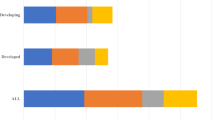
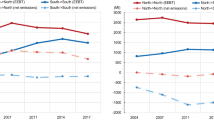
The agricultural sector plays a crucial role in addressing hunger and has been identified as a key target by the United Nations (UN) for achieving global sustainable development by 2030 (FAO, 2022). It serves as a cornerstone of the international economy, meeting the evolving demands of lifestyles and providing sustenance for a growing global population (Zhao et al. 2020). However, it is important to acknowledge that agricultural activities contribute significantly to GHG emissions, accounting for one-third of anthropogenic GHG emissions worldwide in 2015 (Crippa et al. 2021; Rosenzweig et al. 2020). With the expansion of agricultural product trade, there has been a substantial transfer of GHG emissions, resulting in environmental impacts (Foong et al. 2022; Panchasara et al. 2021). Notably, global agricultural product trade has increased by over sixfold since 1980 (WTO, 2022). Balancing the intricate relationship between agricultural product trade and the embodied GHG emissions becomes a challenge as populations grow and dietary preferences shift towards meat consumption (FAOSTAT, 2022; Pradhan and Kropp, 2020).
The United Nations Framework Convention on Climate Change (UNFCCC) has established regulations to mitigate GHG emissions from production activities within national boundaries (Ogle et al. 2018). However, existing production-based accounting methods fail to consider the GHG emissions associated with international trade, resulting in incomplete assessments of global and national emissions. International trade plays a critical role in bridging the gap in domestic production and ensuring food security. While importers benefit from agricultural product trade, the environment of exporters is impacted by the pollution generated during production. The environmental consequences of agricultural product exchange between countries have become increasingly significant. The GHG emissions linked to global agricultural trade increased from 3.86 Gt CO2 e/yr in 1978 to 5.02 Gt CO2 e/yr in 2015 (Foong et al. 2022). Thus, trade liberalization’s implications for GHG emissions merit thorough consideration in the broader context of global emissions.
Along with the process of globalization, China has assumed a paramount role in international trade, particularly in the realm of agricultural product trade. In 2000, China’s agricultural product imports totaled $19.5 billion. However, this figure has experienced a remarkable surge, reaching $219.8 billion in 2021, indicating an average annual growth rate of 12.2% (NBSC, 2022). Consequently, China has emerged as the leading global importer of agricultural products (FAO, 2019). This substantial expansion in China’s agricultural product trade has not only bolstered its share of the global trade market but has also entailed a substantial transfer of GHG emissions between China and other nations. This transfer is a key reason why this paper needs to account for GHG emissions from imports. However, when accounting for China’s net agricultural imports, it is inappropriate to directly calculate the net import data due to differences in emission factors between imported and exported products. The focus of our paper is more on exploring the impact of national policies on agricultural imports and GHG emissions, rather than concentrating solely on import, export, or net import data. Therefore, clarifying the environmental effects of China’s agricultural imports, and in-depth exploration of the specific impacts of these imports on the transfer of GHG emission under national policies, are crucial for optimizing the structure of agricultural imports, ensuring the effective supply of agricultural products, and formulating effective GHG emission reduction plans.
China’s agricultural product trade has been accelerated by its FTAs. It has signed 19 FTAs with 26 countries and regions, starting with Association of Southeast Asian Nations (ASEAN) in 2002. China’s agricultural demand is projected to surge in the coming decades (Zhao et al. 2021). This expected increase is attributed to China’s rapid economic growth, industrialization, and urbanization in the coming decades. These developments are likely to drive changes in income levels, demographic shifts, and adjustments in dietary structures, consequently leading to a significant rise in China’s agricultural demand and an increasing dependence on imports (Liang et al. 2022). This poses a complex empirical question regarding the impact of agricultural product trade liberalization on embodied GHG emissions (Baylis Kathy, 2021; Himics et al. 2018). To date, the impact of FTAs policies on embodied GHG transfers has also not been quantitatively analyzed.
This study aims to fill the research gap by examining the impact of China’s FTAs on the embodied GHG emissions in its agricultural product imports. By analyzing the embodied GHG emissions of 367 agricultural products from 119 major trading countries in China’s agricultural imports between 2000 and 2015, this study utilizes a Propensity Score Matching (PSM)-progressive Differences-in-Difference (DID) model to assess the effect of China’s FTAs shocks on embodied GHG emissions in agricultural imports. Furthermore, the study conducts robustness tests to ensure the reliability of the empirical findings. The results provide theoretical and empirical insights to inform the formulation of policies by the Chinese government, aiming to optimize the ecological environment and trade structure.
As countries worldwide actively seek to reduce carbon emissions and decarbonize to improve the global atmospheric environment, the issue of quantifying GHGs in international trade has gained increasing attention from scholars. For example, Zhao et al. (2023) utilized the global environmentally extended multiregional input-output (EE-MRIO) model to estimate the embodied GHG emissions from international agricultural trade involving 189 countries. Similarly, Liang et al. (2023) used the EE-MRIO model to estimate the GHG emissions from a consumption perspective for 17 regions (particularly Russia, Australia, and Malta) from 1995 to 2019. On the other hand, Mangir and Şahin (2022) focused on Turkey’s import trade in 2015 using the same model and found that the embodied GHG emissions from Turkey’s import trade constituted approximately 9.67% of its total GHG emissions. Additionally, some scholars, such as Liu et al. (2022) and Wang et al. (2023), have focused on the transfer of a single GHG or a specific agricultural product in international trade. While these studies offer valuable references for accounting for embodied GHG emissions, they have generally paid little attention to the impact of national policy measures on the GHG emissions in international trade.
Agricultural product trade, particularly in China, is associated with significant embodied GHG emissions (Meng et al. 2022a). Researchers investigate the impact of trade policies on agriculture as trade liberalization expands (Nie et al. 2022). Adapting trade policies based on country-specific agricultural consumption patterns can reduce embodied GHG emissions from agricultural trade (Foong et al. 2022). The effect of trade liberalization on agricultural trade is debated, with evidence suggesting positive outcomes for food security, poverty reduction, and undernutrition alleviation (Simola et al. 2022). Additionally, trade liberalization has been proven to positively impact national welfare, as evidenced by free trade facilitating the export of rice from Andhra Pradesh, which in turn has increased the income of rice producers (Reddy et al. 2013). Free trade organizations like European Free Trade Association (EFTA), ASEAN, and Mercosur have been found to decrease GHG emissions (see Fig. 1) (Balogh, 2022; Han et al. 2022; Mai, 2021). However, trade liberalization in developed regions weakens global mitigation efforts, despite reducing agricultural GHG emissions within their borders (Himics et al. 2018). Similar findings have been observed in less-developed regions like Africa (Janssens et al. 2022). While trade liberalization brings economic income and advanced technology, it can also shift pollution-intensive activities to countries with less stringent environmental regulations (Barros and Martínez-Zarzoso, 2022). In particular, as trade liberalization increases, the mitigation of global GHG emissions becomes significantly less efficient (Wang et al. 2022a). Examining the impact of agricultural trade policies on global GHG emissions, coupled subsidies are found to stimulate agricultural emissions, while trade interventions such as border restrictions reduce emissions (Laborde et al. 2021). Existing studies have focused on Europe, Africa, and North America, with limited consideration for China (Galvan-Miyoshi et al. 2022).

China’s agricultural trade policies have a significant impact on global climate change due to its position as the largest agricultural importer and second-largest exporter (Han et al. 2019). Previous studies have explored the effects of various agricultural trade policies in China, including cotton subsidies, tariffs, and trade barriers (Wang et al. 2022b; Yao et al. 2021; He et al. 2019). These studies have contributed to understanding the influence of administrative policies on GHG emissions in agricultural product trade (Nie et al. 2022; Thompson and Toledo, 2022). However, the impact of China’s FTAs on agricultural trade GHG emissions remains unclear.
China’s FTAs, driven by its objective to adapt to economic globalization, plays a crucial role in promoting trade liberalization and creating development opportunities (Fan et al. 2022; CEN, 2016). With approximately 35 percent of China’s total trade attributed to FTAs partners, understanding the impact of China’s FTAs on embodied GHG emissions from agricultural product trade is vital (Daily, 2022). Our study aims to contribute to policy-making by conducting a detailed analysis of the embodied GHG emissions in China’s agricultural imports, with a specific focus on the potential influence of FTAs on GHG emission transfers.
International trade in agricultural products can separate production from consumption. The current production-based accounting method typically assigns GHG emissions to the production region (IPCC, 2006), which overlooks the inter-country transfer of GHG emissions. This limitation creates a challenge in ensuring equitable distribution of emission rights, resulting in the dilemma of “inequity in emission rights”.
This study aims to provide a comprehensive assessment of the embodied GHG emissions associated with agricultural product imports in China, using the GHG emissions factors (CEF) approach. The CEF method considers the entire production chain of commodities and services, allowing for a consumption-based accounting of the GHG emissions embodied in these goods. However, it should be noted that the Food and Agricultural Organization of the United Nations (FAO)‘s CEF, which categorizes agricultural GHG emissions by activities rather than specific products, may not accurately reflect the diverse agricultural technology and resource endowments among countries. This misalignment may lead to misguided policy decisions.
The existing research on the nexus between GHG emissions and international agricultural product trade is limited. Furthermore, the FAO’s CEF does not account for emissions associated with commodity trade, and it lacks the ability to analyze temporal trends without proper calibration. To address these limitations, this study adopts the improved set of CEF developed by Hawkins et al. (2016a), which allows for the accounting of direct and indirect GHG sources over time. This approach helps in understanding how China’s changing crop and livestock preferences influence GHG emissions. The superiority of Hawkins et al.‘s CEF is confirmed by comparing the calculated results with the corrected FAO’s CEF in a study by Meng et al. (2022b), which focused on estimating GHG emissions of corn, rice, wheat, and livestock products. Consequently, the CEF from Hawkins et al. (2016b) is chosen as the benchmark due to its comprehensive coverage of agricultural products and long time series data. The specific carbon emission factors are provided in Table S1.
China’s participation in FTAs reflects its commitment to global economic integration, leading to partnerships with countries worldwide. For the purpose of this study, China’s geographical boundary is defined as the Chinese mainland, excluding Hong Kong, Macau, and Taiwan Province, based on data availability. The analysis focuses on the embodied GHG emissions associated with 367 agricultural products traded between China and 119 importing countries or regions. Our study considers the emission boundaries of agricultural GHG, including carbon dioxide, methane, and nitrous oxide. To analyze agricultural production activities, the classification standard of FAO is utilized, categorizing activities into crop and animal livestock. It is important to note that feed grain represents a unique case. While it is an agricultural crop, its CEF originates from the production of vegetable foods that serve as animal feed. Following the approach of Lin et al. (2015), this study incorporates feed as an input to livestock production, counting it in crop production to prevent double-counting. The specific boundaries for agricultural production GHG accounting are detailed in Appendix Fig. S1.
GHG emissions associated with crop products stem from various sources. These include carbon dioxide (CO2) emissions resulting from the use of production inputs like pesticides and agricultural films, as well as energy consumption. Methane (CH4) emissions are generated during rice planting, while nitrous oxide (N2O) emissions arise from manure application and crop residues. Combustion processes also contribute to the emission of CH4 and N2O. To assess the GHG emissions associated with agricultural products, we employ the carbon emission coefficient method. This method takes into account the emissions from each specific emission source and combines them with the corresponding activity levels to calculate the overall GHG emissions attributed to planting activities. The calculation formula is as follows:
In formula (1), \(>_\) is the total GHG emission of crop products, \(_\) , \(_
The GHG sources of livestock products include livestock production inputs (such as veterinary drugs, feed, etc.), CH4 produced by intestinal fermentation, CH4 and N2O produced by manure management. GHG calculation formula of livestock products is as follows:
$$>_=\sum _\sum _(_\times >_<(<\rmTo examine the causal link between trade liberalization and GHG flows resulting from agricultural imports, this study adopts China’s free trade area policy as an exogenous policy shock and applies the DID model to identify the policy’s net effect. The DID model is a widely used econometric method to assess policy implementation effects (Fanghella et al. 2022; He et al. 2020). However, it is crucial for the DID model to meet the parallel trend assumption to avoid sample selection bias, which could compromise the reliability of the model results (Baker et al. 2022).
To address potential sample selection bias and endogeneity issues, this study employs PSM to construct counterfactual events by identifying samples with similar characteristics from the experimental and control groups. While PSM helps mitigate sample selection bias, it faces challenges in addressing endogeneity problems (Zhang et al. 2022). To overcome these limitations, the study utilizes the PSM-progressive DID model to evaluate the relationship between trade liberalization and GHG flows resulting from agricultural imports. Furthermore, the study employs various robustness tests to ensure the reliability and scientific validity of the regression results. This approach allows for a more accurate and scientifically sound assessment of the GHG treatment effects of China’s FTAs.
Step 1: PSM sample matching. Based on whether it is a fictitious variable Treat of China’s FTAs country, this paper adopts the Logit method for regression of the covariable, and calculates the predicted probability value of each country signing an FTAs with China. Then the 1:1 nearest neighbor matching method was used to screen out the national samples that most fit the characteristics of the FTAs member states in the experimental group from the control group, so as to effectively reduce the non-random selection bias. For specific model Settings, see Formula (S1) in supplementary materials.
Step 2: DID model construction. Given the variation in the establishment time of China’s FTAs, the traditional DID model is insufficient in addressing the heterogeneity of effects resulting from different policy implementation timings, leading to potential bias in the estimated results. To overcome this limitation, this study employs the progressive DID model for estimation. The model is formulated as follows:
$$Ln>_=_+_>_\times >_+<\xi >__+<\gamma >_+<\mu >_+_$$In Formula (6), LnAGHGit is the dependent variable and represents the logarithm of embodied GHG emissions from China’s imported agricultural products (AGHG). Subscripts i and t represent countries and years respectively. FTAi × Timeit is the core explanatory variable of this paper, indicating whether country i has implemented the China’s FTAs in year t, which also means country i has established an FTAs relationship with China and is implementing the FTAs in the year with the value of 1. If country i has not established an FTAs relationship with China or has signed an FTAs but the agreement has not taken effect, the value is 0. In addition, regression coefficient FTAi × Timeit of β1 is the net effect of FTAs, indicating the impact of China’s FTAs on the embodied GHG emissions of agricultural trade, and the expectation β1 is significantly positive. γt and μi represent time fixed effect and country individual fixed effect respectively. β0 is the intercept term. \(_\) represents the selected control variable. εit stands for the random error term.In this study, the embodied GHG emissions of agricultural products imported by China were utilized as the dependent variable to measure the GHG transfer situation. These emissions were calculated using the formula described in Section “Accounting method” earlier.
In this paper, we examine China’s FTAs as a quasi-natural experiment, and the interaction term between the country dummy variable and the time dummy variable represents the policy treatment effect of China’s FTAs (FTA × Time). Specifically, the group dummy variable FTAs for China’s FTAs partner countries is set to 1 for the experimental group; 0 for the control group. The policy time dummy variables Time before and after the implementation of China’s FTAs are set to 0 and 1, respectively. Considering that China’s FTAs relationship with FTAs partner countries includes two points in time, the signing of the agreement and its implementation, this paper unifies the implementation time as policy implementation time.
We introduce control variables to avoid endogeneity problems due to the emission of relevant variables that have an impact on the agricultural product import related embodied GHG emissions in China. Drawing from relevant literature (Balogh, 2022; Drabo, 2017), we select the following control variables that are known to influence the embodied GHG emissions associated with agricultural product imports in China: gross domestic product (GDP), distance between two countries (DTE), per capita arable land (PAL), degree of openness (OPD), and agricultural mechanization level (AML). The selection and definition of control variables are shown in Supplementary Material Table S2.
China’s establishment of a socialist market economy system in 2000 has led to accelerated economic integration, opening up, and the implementation of the FTAs. Between 2000 and 2015, China signed and implemented FTAs with 19 countries, including ten ASEAN countries, Pakistan, Chile, New Zealand, Singapore (ASEAN member state), Peru, Costa Rica, Iceland, Switzerland, South Korea, and Australia. The timeline of FTAs signing and implementation between China and other countries is depicted in Supplementary Material Table S3. However, for the purpose of this study, South Korea and Australia are excluded from the experimental group due to the relatively short duration of the FTAs signed with these countries. Given the substantial sample size and the availability of comprehensive data, we selected 119 major agricultural import partners of China during the period from 2000 to 2015 (see Table S4) to establish the study sample. The 367 agricultural products included in the analysis are categorized into 15 categories, such as beef, pork, sheep, poultry, milk, eggs, maize, rice, wheat, pulses, oil crops, sugar, fruits, vegetables, and roots (see Table S5). Data on China’s agricultural product imports were obtained from the Food and Agriculture Organization of the United Nations (FAO, 2022) and the China Customs Yearbook (CCSY, 2017). The GDP, arable land area, openness, and mechanization level of the 119 countries in the study sample were sourced from the World Bank World Development Indicators database (Bank, 2022). Missing data for certain years were filled by either taking the average of adjacent years or using linear interpolation. Consequently, the analysis of the DID model is based on balanced panel data covering the period from 2000 to 2015. Descriptive statistics of the main variables are provided in Table S6.
Figure 2 demonstrates the embodied GHG emissions of 15 categories of agricultural products from the top ten source countries of China’s agricultural imports, which can visualize the changing trends of the sources of embodied GHG emissions during the study period.
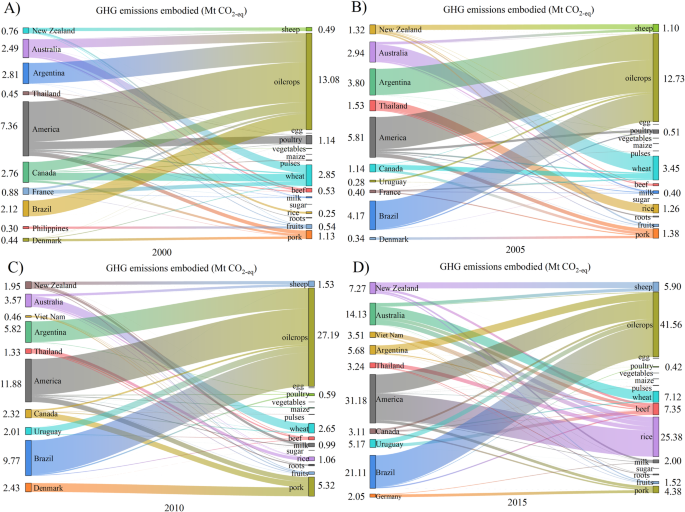
In 2000, the United States, Argentina, Canada, Australia, Brazil, France, New Zealand, Thailand, Denmark, and the Philippines were responsible for 92.55% of the GHG emissions embodied in China’s agricultural product imports. Among the various agricultural products, oil crops, wheat, poultry, and pork accounted for a significant proportion (around 89.38%) of the embodied GHG emissions in China. During the period of 2000–2005, the trend of GHG emissions embodied in China’s agricultural product imports exhibited a relatively modest increase, with a growth of 0.51 Mt CO2-eq. However, after 2005, there was a significant surge in the GHG emissions embodied in China’s agricultural product imports, reaching 107.70 Mt CO2-eq in 2015, representing an increase of 85.69 Mt CO2-eq and an annual growth rate of 11.16%. Given the timing of China’s FTAs implementation and the observed growth trends in GHG emissions, there is a suspicion that the FTAs contributed to the rise in embodied GHG emissions associated with China’s agricultural product imports. It is noteworthy that despite the overall growth in GHG emissions, the embodied GHG emissions in pork import experienced a significant decline in 2015. This decline can be attributed to a Chinese government policy that restricted imports during that year to prevent the spread of swine flu.
Between 2000 and 2015, the United States accounted for the majority of embodied GHG emissions from China’s agricultural imports, ranging from 7.36 to 31.18 Mt CO2-eq. Brazil and Australia have also increased their GHG emissions transfers to China and now rank higher than before. Figure 2 illustrates that Brazil’s GHG emissions increased by 895.75% during this period, rising from 2.12 Mt CO2-eq in 2000 to 21.11 Mt CO2-eq in 2015. This makes Brazil the second-largest source of GHG emissions associated with China’s agricultural trade, following the United States. Australia followed a similar growth trend, the total embodied GHG emissions increased by 11.64 Mt during this period. In 2000, 2005, and 2010, oil crops accounted for the highest amount of embodied GHG emissions. In 2015, Beef and pork surpassed oil crops in terms of embodied GHG emissions, reaching 7.35 Mt CO2-eq and 4.38 Mt CO2-eq, respectively. Beef and pork together contributed to approximately 12.17% of the total embodied GHG emissions, indicating that the imports of meat agricultural products in China have led to an increase in embodied GHG emissions. More than 55% of the total embodied GHG emissions from China’s agricultural product imports can be attributed to several types of agricultural products, including oil crops, beef, and pork. It’s noteworthy that the embodied GHG emissions from rice have seen a significant increase over the study period. This trend may be attributed to China’s increasing industrialization and urbanization, which have resulted in the reallocation of resources, such as land and labor from the agricultural sector to the secondary and tertiary sectors. This shift has constrained China’s domestic rice production, creating a disparity with the rising demand for rice consumption due to population growth. Hence, the international market has become an essential source of China’s rice supply, contributing to the increase in embodied GHG emissions associated with rice (Zhang et al. 2019). These findings indicate that the embodied GHG emissions of imported agricultural products in China have significantly increased from 2000 to 2015, highlighting the substantial impact of China’s trade liberalization policy on GHG emissions. However, the precise quantification of emissions is dependent on further empirical analysis considering the implementation of China’s FTAs.
To further examine the spatio-temporal differentiation characteristics of embodied GHG emissions in China’s agricultural trade imports, this paper presents the changes in these emissions with respect to the trading partners that have signed FTAs. For greater clarity in demonstrating the embodied GHG emissions of FTA agreement partners, we will primarily focus on those trading partners whose GHG emissions exceed 0.1 Mt CO2-eq. Conversely, trading partners with GHG emissions less than 0.1 Mt CO2-eq will be collectively categorized as “others”.
In Fig. 3, the embodied GHG emissions from China’s agricultural imports via FTA agreement trading partners demonstrated an overall upward trend during the study period. The total embodied GHG emissions from these partners surged from 1.86 Mt CO2-eq in 2000 to 16.15 Mt CO2-eq in 2015, marking an increase of 14.30 Mt CO2-eq. This represents an average annual growth rate of 14.34%. During the intervals 2000–2005, 2005–2010, and 2010–2015, the embodied GHG emissions increased by 72.65%, 30.26%, and 286.54%, respectively. In 2000, New Zealand had the highest embodied GHG emissions among China’s FTA partners, about 0.76Mt CO2-eq, followed by Thailand, the Philippines, Indonesia, and Viet Nam. Together, these five regions contributed 95.43% to the total embodied GHG emissions from China’s FTA trading partners that year. The Thailand’s embodied GHG emissions in 2005 rose to 1.53 Mt CO2-eq, surpassing New Zealand as China’s largest source of embodied GHG emissions among FTA partners. New Zealand’s emissions continued to increase in 2010–2015, re-establishing it as China’s largest trading partner in terms of embodied GHG emissions under FTAs. This significant growth in embodied GHG emissions from China’s FTA trading partners demands further empirical analysis to understand the extent to which FTAs have influenced these increases.
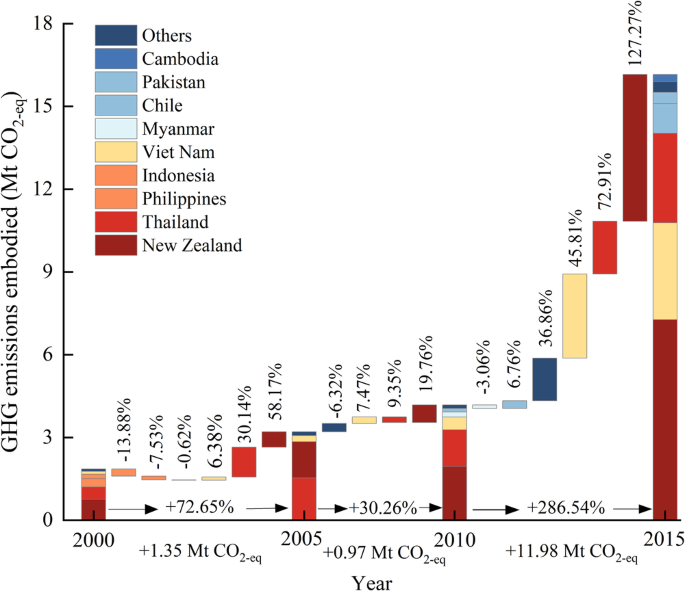
To address potential sample selection bias and ensure the accuracy of assessment results, this study employed the PSM method. PSM was used to match the samples and mitigate any differences in characteristic variable trends between the experimental and control groups before policy implementation. This approach helps to establish a more reliable basis for evaluating the impact of the policy. In this study, the covariates considered for matching were GDP, DTE, PAL, OPD, and AML. Propensity score matching was performed using Formula (S1) to ensure a balanced distribution of these variables between the experimental and control groups. The balance test results before and after matching are presented in Table 1. The % bias values after matching, which are below 5% (Hu and Shi, 2021), indicate that the sample means of the different control variables in the experimental and control groups are evenly distributed, satisfying the requirements of the balance test. The p-values suggest that there were no significant differences in GDP, DTE, PAL, OPD, and AML between the experimental and control groups after the propensity score matching treatment. This finding implies that the effect of the China-trading partners’ FTAs implementation is independent of the matching variables. It aligns with the assumption of “parallel trend” in causal inference (Zhu et al. 2020), supporting the validity of the study’s causal analysis.
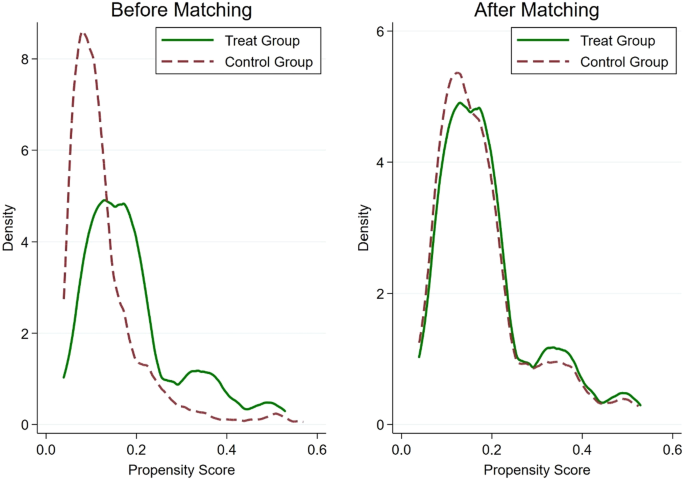
We first examine the impact of the FTAs on the embodied GHG in China’s agricultural product imports and use formula (6) to estimate the model. The progressive DID regression results are shown in Table 2. The coefficient of China’s FTAs is significantly positive at the 5% level. As indicated in columns (2) and (4) of Table 2, the regression results also show positive coefficients for China’s FTAs after the inclusion of control variables, and all regression coefficients are relatively stable in magnitude. That is, China’s FTAs lead significant increases agricultural product imports related embodied GHG emissions in China.
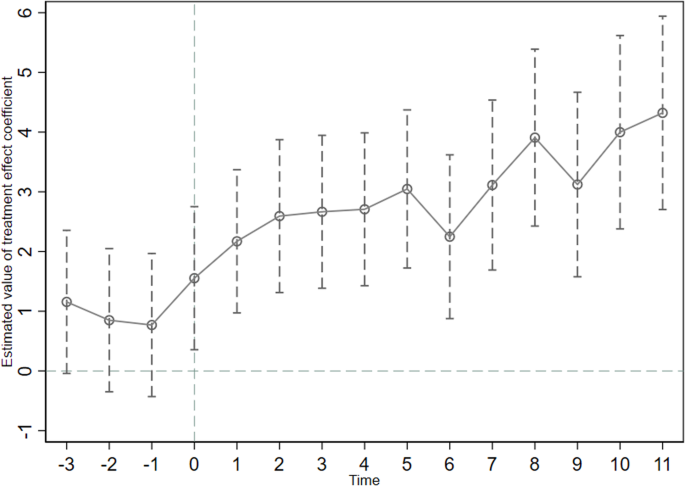
The regression results are shown in Fig. 5. The x-axis represents the policy timeline, with the long dashed line on the y-axis denoting the year of policy implementation, where the horizontal coordinate 0 represents the year 2004. The y-axis shows the estimated coefficients, and the long dashed line on the horizontal axis indicates an estimation coefficient of zero. In Fig. 5, the circles represent the estimated coefficients at each policy point, and the broken dashed lines extending upwards and downwards represent the confidence intervals calculated at a 95% significance level using robust standard errors. The study finds that the coefficient estimates for each period prior to the implementation of China’s FTAs are found to be insignificant. This indicates that there was no significant difference in agricultural product import-related embodied GHG emissions between China’s FTAs partner countries and non-partner countries before the policy implementation. The parallel trend check provides evidence that the sample satisfies the parallel trend assumption required for the progressive DID model. As time passes and more partner countries sign FTAs with China, the impact of the FTAs continues to grow. This suggests that the effect of China’s FTAs on agricultural product import-related embodied GHG emissions in China is persistent and does not exhibit any lag. These findings support the robustness of the analysis and strengthen the reliability in the results obtained from the progressive DID model.
To ensure the accuracy and reliability of the policy evaluation results, a placebo check is conducted to account for the potential influence of other policies or randomizing factors on the experimental and control groups after the implementation of China’s FTAs. The placebo check involves randomly dividing the experimental and control groups while maintaining a consistent sample size for the experimental group. The policy implementation time for the experimental group is also randomly generated according to formula (6), allowing for the assessment of the virtual policy effect. Through 1000 random simulations, the estimated coefficients of the policy are plotted as a probability density distribution (Fig. 6).
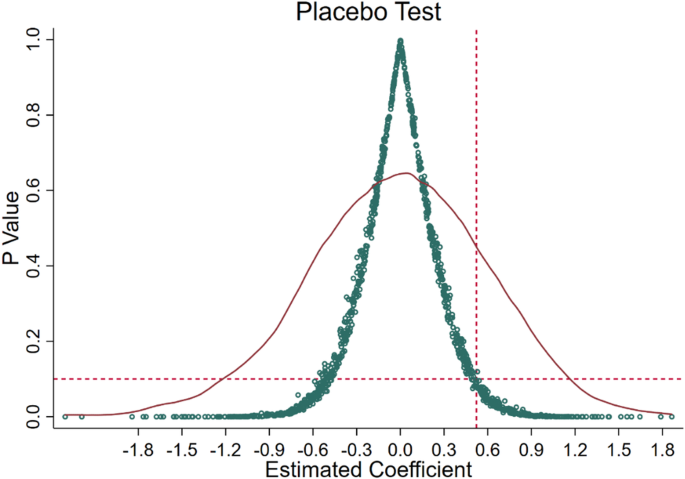
Figure 6 illustrates the estimated coefficients and their corresponding p-value distributions obtained during the 1000 simulations. Here, the x-axis indicates the magnitude of the estimated coefficients; the y-axis shows the density values and the magnitude of the p-values; the curves represent the kernel density distributions of the estimated coefficients; the green dots signify the p-values corresponding to the estimated coefficients; the vertical dashed line marks the true estimate of the DID model, while the horizontal dashed line represents the significance level of 0.1. Meanwhile, the estimated coefficients are mostly clustered around zero, and most of the estimates have p-values greater than 0.1 (which is not significant at the 10% level). This suggests that our estimates are unlikely to have been obtained by chance, and thus are unlikely to have been influenced by other policy or stochastic factors. Thus, the placebo test is successful, as there is a very low probability that the observed policy effect in the experimental group is caused by factors other than the FTAs. We can confidently assert that the policy effect of China’s FTAs on agricultural product import-related embodied GHG emissions is not significantly influenced by potential unobserved stochastic factors. Thus, the regression results obtained are highly robust and can be considered reliable for policy evaluation purposes.
Various sample matching methods are available in the PSM model, and it is possible that the choice of matching method may affect the results of model estimation. To avoid the results being generated by chance, the kernel matching method and the radius caliper matching method, which are different from the 1:1 nearest neighbor matching method (see in Section “GHG accounting of livestock products”), are chosen to re-process the samples, and the processed matching data are re-estimated, respectively. Table 3 presents the PSM matching results after changing the matching method and Table 4 shows the regression results after changing the matching method. The estimated coefficients of the policy under both kernel matching and radius caliper matching methods are not significantly different from the regression results in Table 2 above in terms of size, sign and significance, confirming the robustness of the regression results.
Table 3 The PSM matching results after changing the matching method. Table 4 The effect of the FTAs by change propensity score matching matches.Although the estimation results under different treatments share the same trend, symbol, and significance level, their specific values differ. The main reason is that different matching algorithms have different matching standards for samples, which results in different sample selections and losses. Therefore, the experimental group chooses different control groups under different matching methods, resulting in slightly different regression results (Zhang et al. 2022).
In order to further verify the stability and reliability of the benchmark regression results, this paper uses formulas (S1) and (6) to conduct regression estimation according to the accounting results after excluding four partner countries with high embodied GHG emissions, including the United States, Brazil, Argentina and Australia, and observes the changes in the results after eliminating samples with large impacts to test the robustness of the regression results as shown in Table 5. Compared with Table 2, the regression results after excluding some typical samples and the benchmark regression results are not significantly different in size and significance. It can be seen from column (4) that the regression coefficient of FTA × Time is still positive after trend matching, and it is also significant at the 10% level, which again shows that China’s FTAs does increase the embodied GHG emissions of agricultural product imports.
Table 5 Regression results with part samples removed.As China’s FTAs partner countries have a wide range of economic development levels, it is crucial to examine the relationship between the different economic development levels of the partner countries and the embodied GHG emissions associated with agricultural imports further. On the basis of the World Bank’s 2015 economic level classification criteria (Bank, 2015), the countries of China’s FTAs partners with national per capita incomes above $12,735 are classified as high-income countries (regions), whereas the rest are classified as low- and middle-income countries (regions). The results of the heterogeneity analysis are listed in Table 6. Columns (1) and (2) of Table 6 show the regression results for high-income countries (regions) without and with control variables, while columns (3) and (4) show the regression results for low- and middle-income countries (regions) without and with control variables. At the 5% level, the regression coefficient (0.8509) for low- and middle-income partner countries (regions) is significant and higher than the total sample coefficient (0.5298). Meanwhile, the regression coefficient for high-income partner countries (regions) is negative and insignificant.
Table 6 The regression results of heterogeneity analysis.The results show that China’s FTAs effects significantly promote the increase of GHG emissions from low and middle-income partner countries (regions). The embodied GHG transfer of China’s agricultural product imports from low and middle-income countries (regions) increased from 10.83 Mt CO2-eq in 2000 to 32.71 Mt CO2-eq in 2015. In comparison with non-agreement countries, China’s FTAs has increased GHG transfers by 85.09% from low and middle-income countries, which is consistent with (Hong et al. 2022) ‘s study proving their scientific validity. As can be seen, China’s FTAs is a double-edged sword. It promotes economic integration and benefits the economy, but also increases the transfer of embodied GHG emissions.
The total of 15 categories of agricultural products are discussed in this paper, which is further divided into three groups: grain and oil products, fruit and vegetable products, and livestock products. Table 7 gives a detailed classification, as a result of the export situation of various countries, China’s agricultural product imports partners were divided into grain and oil exporters, fruit and vegetable exporters, livestock exporters, The benchmark regression method was used for regression estimation. The regression results (see in Table 8) showed that China’s FTAs has significantly promoted the increase of the transfer of embodied GHG emissions in agricultural products trade in grain and oil products producing countries and livestock products producing countries. For the imports of China’s agricultural products, the FTAs of China have played a positive driving role in increasing the GHG emissions from grain and oil exporting countries. Similarly, China’s FTAs have also positively influenced the increase in GHG emissions from livestock exporting countries, although the positive effect is not as pronounced as in the former case. However, in fruit and vegetable exporting countries, there is no apparent driving effect on embodied GHG transfer. The possible explanation is that the China’s FTAs has greatly promoted the increase of grain and oil products and livestock products by reducing tariffs and improving trade facilitation, thus driving the transfer of embodied GHG to China. Although the production of fruit and vegetable products is limited by natural conditions such as climate and light, China imports most of its fruit and vegetable products from countries like Thailand, New Zealand, and Viet Nam, and the import volume is relatively high, so the impact of FTAs in this field is less obvious.
Table 7 Division of three major agricultural products. Table 8 Regression results of heterogeneity analysis of agricultural products.Our study examines the implications of China’s FTAs on the GHG emissions embodied in its agricultural product imports. By utilizing the PSM-progressive DID model, the study evaluates the effectiveness of the policy and conducts rigorous robustness tests and heterogeneity analyses. The key findings of this study are as follows:
(1) China’s FTAs have resulted in a “double-edged sword” effect on agricultural product imports. From an economic perspective, the policy has a significantly positive impact on agricultural product imports in China. The total imports of agricultural products in China have experienced an average annual growth rate of 12.22%, contributing significantly to the development of economic integration. However, the FTAs also have a negative impact on the transfer of GHG associated with agricultural product imports. The embodied GHG emissions from China’s agricultural product imports have continuously increased from 22.01 Mt CO2-eq in 2000 to 107.70 Mt CO2-eq in 2015. As a result of the FTAs, the embodied GHG emissions from China’s agricultural product imports have risen by 53.0%.
(2) Distance between trading partners (DTE) and agricultural mechanization level (AML) have a restraining effect on embodied GHG transfers. It emphasizes the importance of promoting cleaner agricultural practices in FTAs partner countries with high levels of mechanization.
(3) It is observed that low- and middle-income partner countries (regions) have experienced an 85.09% increase in GHG emissions embodied in agricultural product imports as a result of FTAs partnerships. On the other hand, the regression coefficient for high-income partner countries (regions) is negative and insignificant.
China’s agricultural sector has gained attention with the growth of imported agricultural products contributing to embodied GHG emissions and posing challenges for China’s carbon neutrality goals (Foong et al. 2022; Piao et al. 2010). It is crucial for China to learn from developed countries’ experiences in managing international agricultural imports and develop effective solutions to reduce the transfers of embodied GHG emissions. This study provides policy implications and acknowledges research limitations.
China should expand and deepen its FTAs. Currently, China’s FTAs primarily covers the Asia Pacific region and can be expanded to cover the whole world. In the future, China should prioritize objectives such as accelerating the development of the China’s FTAs, forming partnerships with high-income countries, attracting more high-income countries to join China’s FTAs, and improving the quality of Chinese agricultural imports.
Standards and guidelines for accessing agricultural imports should be continuously optimized. China may adopt higher import quality standards and implementing differentiated tax preferential policies to effectively reduce the import of high-GHG agricultural products. Improving access standards can incentivize trade partners to innovate, enhance the production efficiency of agricultural products, and further reduce the embodied GHG emissions in import.
The government needs to expedite the optimization of its primary agricultural import sources. At present, the sources of China’s agricultural imports are highly concentrated. Therefore, there is an urgent need to further promote the diversification of agricultural import markets and the variety of products imported. Meanwhile, China should strive to increase its imports of general consumer agricultural products to better satisfy the growing needs of its people. China’s FTAs provides an opportunity to introduce advanced production concepts and technologies, reduce the use of chemical fertilizers and pesticides, promote organic and ecological agriculture, increase agricultural productivity, and build a green and efficient agricultural production system.
The limitations of this study and future research are summarized below: firstly, our study categorizes over 300 agricultural products into 15 major categories, which results from a compromise that considered data accessibility. Even if there is not much variability among the agricultural products in one category, there are still uncertainties in the emission factors that can challenge the accuracy of the results. Secondly, due to data availability and technical constraints, the analysis focuses on embodied GHG emissions from 2000 to 2015. Future research can explore the impact of China’s FTAs and trade policies of exporting countries on China’s agricultural product imports using updated data. Furthermore, this study estimates the embodied GHG emissions from China’s agricultural import trade within specific accounting boundaries. It does not encompass all sources of embodied GHG emissions in the agricultural products’ supply chain, indicating a need for more detailed future research.
The original contributions presented in the study are included in the article/Supplementary Material, further inquiries can be directed to the corresponding author.